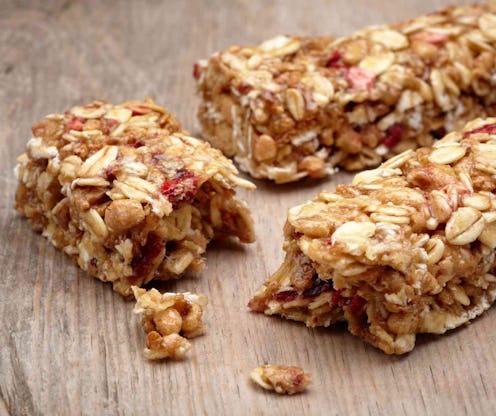Life
How to Read the Label on a Nutrition Bar

For anyone who's been health-conscious for any period of time, there's probably been at least once when your food choice let you down. You were loving that salad until you realized the fat in the dressing gave it more calories than a plate of fried chicken. You loaded up on coconut water at the gym, only to find out it wasn't so different than juice. Also out to get you: so-called nutrition bars.
We've got a super-handy and thorough guide to healthy nutrition bars, but if you're looking at one that's not included on our list, these six steps will help you figure out if it really follows its promise of being nutritional. We asked a nutritionist to walk us through the ingredients commonly found on granola bars, to find out what those crazy looking words really mean, what's just code for chemical, and what's really, truly good for you.
1. Sugar Content
“This number should be as low as possible, preferably somewhere between 8 and 10 grams per bar,” says Lauren Minchen, RD. The troubling truth is that many bars are equal in sugar content to candy bars! Avoid bars with artificial sweeteners such as aspartame, acesulfame-k and sucralose. “Sugar alcohols can cause diarrhea for some, so I would limit those as much as possible,” Minchen says. First priority though: avoiding artificial sweeteners and keeping total sugar content topped at 8 to 10 grams.
2. How Processed is it?
This can be hard to determine just from reading a label. In general, Minchen recommends the following rule of thumb: “The more ingredients on the label that you can't pronounce, the more processed it will be,” she says. “Aim for bars that include mostly ingredients that you recognize, and that are in their natural form.”
3. The Nutrients Situation
Bars in general are limited when it comes to nutrients. There are many bars that are fortified with a range of vitamins and minerals, but often the price is paid in double-digit sugar numbers. “I would recommend looking for lower sugar content before worrying about nutrients in bars,” Minchen says. “If nutrients come with low sugar content, that's great, but it's not the top priority. It may be better to pair a fruit or veggie with the bar to get natural vitamins and minerals.”
4. A Vegan's Specialty
Minchen's top tip for shopping for vegan protein bars is to avoid soy protein isolate. “Any isolate proteins have an increased risk of containing heavy metals, due to the way they are extracted,” she says. However, soy tends to be the worst offender. “I personally like Garden of Life vegan bars, because they are pretty clean. However, always be mindful of sugar content.”
5. The Protein Type
Whey powder and brown rice protein are the ideal sources of protein in a bar. Again, while this is harder to-do for vegans, aim to avoid soy protein isolate. Any chia or flax seed protein is a great option. And for that matter, any nut or seed protein is good.
6. Fat Content
According to Minchen, the total fat gram count is not the ultimate concern so much as the type of fat contained. Check the ingredients list for hydrogenated oils or fats: This is code for trans fats, so avoid any bars with hydrogenated or partially hydrogenated ingredients.
Also, saturated fat content can be high in many bars, so, “If you have heart disease or cholesterol issues, I would recommend that you limit your intake of bars with more than 5 to 7 grams saturated fats (unless it is coconut oil-based, in which case the saturated fat can be heart healthy),” Minchen says.
"This can be difficult to do with many bars, so if it's not possible, try to limit your intake of saturated fats for the rest of the day, focusing on fats from avocado, olive oil, flax, chia, and wild fish to help balance your fat intake.”